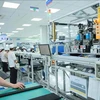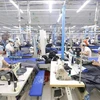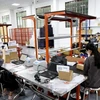Experts believe that it’s now the right time for Vietnam to join the global IC production chain, a golden opportunity to approach to high technologies. Insights from the Vietnam Net online newspaper.
The opportunity has come
Don Tran, Managing Director of Global Equipment Services GES, said the demand for electronic products in Vietnam has been increasing rapidly thanks to the increasingly high percentage of people using Internet and their improved income. Meanwhile, enterprises tend to more utilise the information technology and high technologies in their production and business.
All these could be the favorable conditions for Vietnam to develop a semiconductor IC factory it has been striving for a long time.
According to the official, the heavy investment in the semiconducting industry would help reduce the imports, increase the values of domestically made electronics and ease the reliance on imports.
"I believe that the establishment of an IC factory in Ho Chi Minh City is a right move, because all the necessary factors have got ready, from the labour force, technique, transport and good development policies," he said.
Bettina Weiss, Vice President of SEMI, also thinks that it’s now the right time for Vietnam to join the IC production market. Nowadays, every person owns more than one digital device, which means the demand for IC has been increasing rapidly, he added
Asia- Pacific has emerged as a world’s leading source of IC supply. China’s Taiwan, for example, now holds 13-16 percent of the market share, China 9 percent.
To Thi Thu Huong, Deputy Director of the Information Technology Department under the Ministry of Information and Communications, also said the government has highlighted the IC production as one of the priority industries.
Analysts have predicted that the Vietnamese IC market is worth 2 billion USD a year.
Knowing its own strength
As such, the matter for discussion now is what way Vietnam should follow to develop the semiconductor industry.
According to Huong, there would be many different phases of development. The first would be the time for setting up the infrastructure, designing IC production factories, and building up the workforce, while the next would be the period for development which needs the state’s support to help create the market for domestic products.
In order to do that, it’s necessary to build up the list of the strategic products Vietnam should focus on.
Vietnam now still cannot make the products which require high technologies, the 90 nm – 45 nm chips. Therefore, it would be better to focus on the products which fit its capability in the immediate time.
Pham Ba Tuan from the CNS IC factory project, which is expected to be implemented in the time to come, thinks that the 180 nm technology proves to be most suitable to the Vietnamese current financial capability. If it chooses the 90 nm, the price it has to pay would be triple. Meanwhile, the 180 nm is believed to exist in the next 20 years.
He went on to say that an IC factory would not be enough for the semiconductor industry development. In the future, Vietnam would need to set up research and development (R&D) centres, or the design centres which would test if the products fit the market or not before they are put into mass production.-VNA
The opportunity has come
Don Tran, Managing Director of Global Equipment Services GES, said the demand for electronic products in Vietnam has been increasing rapidly thanks to the increasingly high percentage of people using Internet and their improved income. Meanwhile, enterprises tend to more utilise the information technology and high technologies in their production and business.
All these could be the favorable conditions for Vietnam to develop a semiconductor IC factory it has been striving for a long time.
According to the official, the heavy investment in the semiconducting industry would help reduce the imports, increase the values of domestically made electronics and ease the reliance on imports.
"I believe that the establishment of an IC factory in Ho Chi Minh City is a right move, because all the necessary factors have got ready, from the labour force, technique, transport and good development policies," he said.
Bettina Weiss, Vice President of SEMI, also thinks that it’s now the right time for Vietnam to join the IC production market. Nowadays, every person owns more than one digital device, which means the demand for IC has been increasing rapidly, he added
Asia- Pacific has emerged as a world’s leading source of IC supply. China’s Taiwan, for example, now holds 13-16 percent of the market share, China 9 percent.
To Thi Thu Huong, Deputy Director of the Information Technology Department under the Ministry of Information and Communications, also said the government has highlighted the IC production as one of the priority industries.
Analysts have predicted that the Vietnamese IC market is worth 2 billion USD a year.
Knowing its own strength
As such, the matter for discussion now is what way Vietnam should follow to develop the semiconductor industry.
According to Huong, there would be many different phases of development. The first would be the time for setting up the infrastructure, designing IC production factories, and building up the workforce, while the next would be the period for development which needs the state’s support to help create the market for domestic products.
In order to do that, it’s necessary to build up the list of the strategic products Vietnam should focus on.
Vietnam now still cannot make the products which require high technologies, the 90 nm – 45 nm chips. Therefore, it would be better to focus on the products which fit its capability in the immediate time.
Pham Ba Tuan from the CNS IC factory project, which is expected to be implemented in the time to come, thinks that the 180 nm technology proves to be most suitable to the Vietnamese current financial capability. If it chooses the 90 nm, the price it has to pay would be triple. Meanwhile, the 180 nm is believed to exist in the next 20 years.
He went on to say that an IC factory would not be enough for the semiconductor industry development. In the future, Vietnam would need to set up research and development (R&D) centres, or the design centres which would test if the products fit the market or not before they are put into mass production.-VNA



















